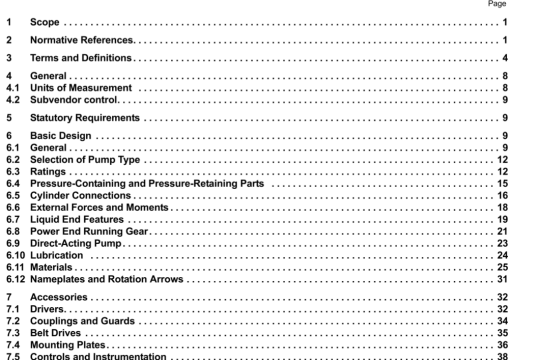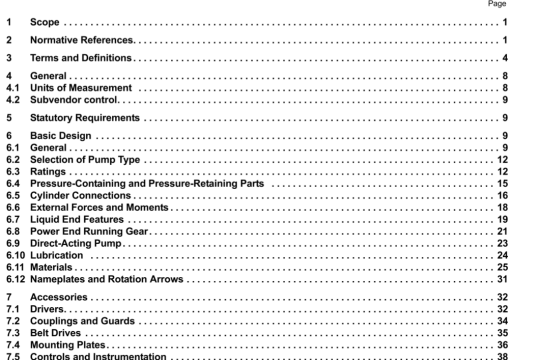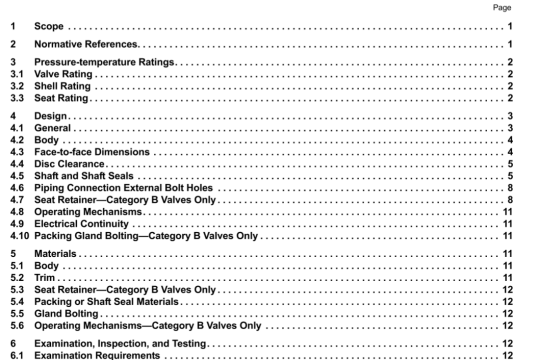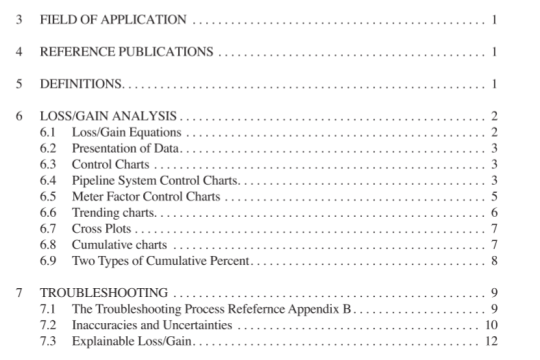API STD 594:2004 pdf download
API STD 594:2004 pdf download.Check Valves: Flanged, Lug, Wafer and Butt-welding.
The total cross-sectional area of the bolts shall be in accordance with the requiremeifls ot’ASMF H 16.34.
4.1.16 When valve design utilizes a stem that extends beyond the pressure boundary. it shall be provided with a means so thai. in the event of a stnwttiral failure of stem-to- closure attachment items, the stem will n04 be ejected through the pressure boundary while the valve is under pressure.
4.2 PLATES AND DISC
Valves are classified as (bllows:
a. A single.platc valve has a plate or disc that closes the valve when (low reversal or gravity forces the plate or disc against the valve-body scat. This closure may be aided by the USC of springs or other devices.
b. A dual-plate valve has plates that close the valve with the assistance of one or more springs, when flow reversal forces the plates against the sralvc4ly seat.
c. For Type ‘A’ single-plate raJves and Type ‘H’ valves, when a nut is used to assemble the disc or plate to the hinge arm, the nut shall be secured to prevent separation: the use of a single tack weld, lock washer or lock nut are not acceptable means.
4.3 SEATING SURFACES
4.3.1 The body and plate or disc seating surfaces may be of deposited weld metal, integral metal, mechanically retained metal, or a resilient material. On Type ‘A’ single-plate valves and Type ‘B valves, a resilient seal ring may be fitted either to the body or plate seat as specified by the purchaser. The ring shall be designed to give a full metal to nwtal seal if the resilient seal is inoperative or removed.
4.3.2 Welding is not permitted on cast iron or ductile iron.
4.3.3 Brazing is permitted on cast iron and ductile iron only for attaching seating surfaces to the body or the plate and only if agreed to by the purchaser and the manufacturer. Furnace brazing is the only type of brazing permitted and may be used only if the parts are heated under closely controlled conditions, in a uniform manner, and to a temperature no higher thaii the lower critical temperawre of the base material. Cooling shall be in the furnace or in still air.
4.4 EXTERNAL BOLTS AND THREADED HOLES
4.4.1 Bolts and threaded holes with a diameter I in. or
smaller shall have coarse (UNC) threads. Those larger than
I in. diameter shall be of the eight-thread series (8 UN).
Bolt threads shall be Class 2A, and nut threads shall be
Class 2B. Threads shall conform to ASM[ B 1.1.
4.4.2 For bolts I in. diameter or smaller, threaded body- flange bolt holes shall be drilled and tapped according to the a.piirements for course thread series
6.3.2 The repair of defects in cast iron or ductile iron castings. by methods such as welding. brazing. plugging. or impregnation. is not permitted.
7 Marking
7.1 NAMEPLATES
Nameplates (see 5.9) of valves made in compliance with this standard shall be marked “API 594” and shall be additionally marked as follows:
7.1.1 For a valve in accordance with ASME H16.34. the markings shall be in accordance with that standard.
7.1.2 For a valve made of other materials, marking shall be in accordance with MSS SP-25.
7.2 LIMITED RATING
Where pressure or temperature rating is limited by construction details or material considerations as described in 3.3. such limited rating shall be marked on the nameplate.
8 ShIpment
8.1 COA11NGS
8.1.1 The machined surfaces of materials that arc not rust resistant shall be coated with an easily removable rust pre. ventive.
8.1.2 Coatings shall not contain lead. Nonferrous and austenitic stainless steel valves shall not be coated. Unless other. wise specified in the purchase order, the external surfaces of valve bodies shall be painted with the following colors:
a. Carbon and low—alloy steel-aluminum.
b. Ductile iron—green.
c. Cast iron—black.




